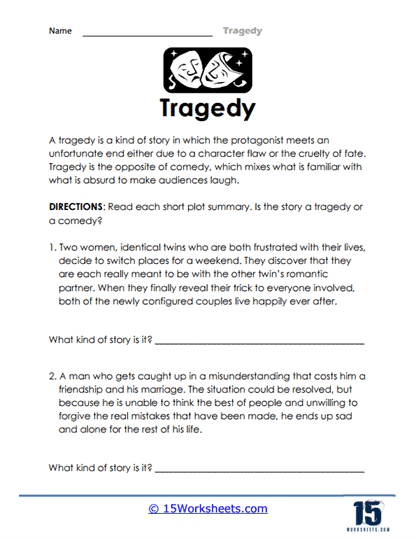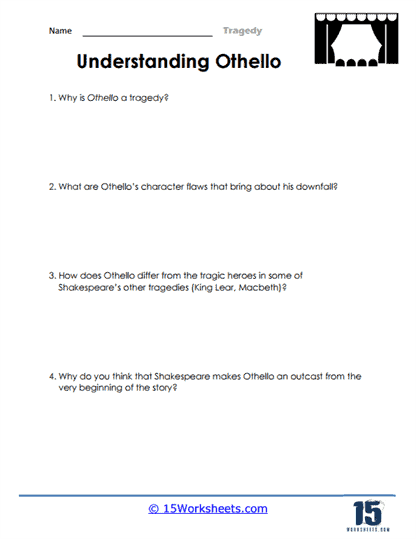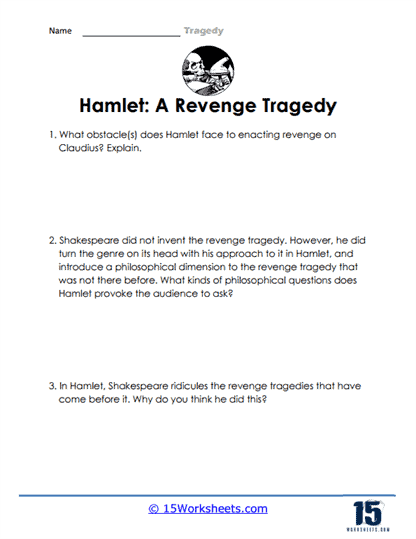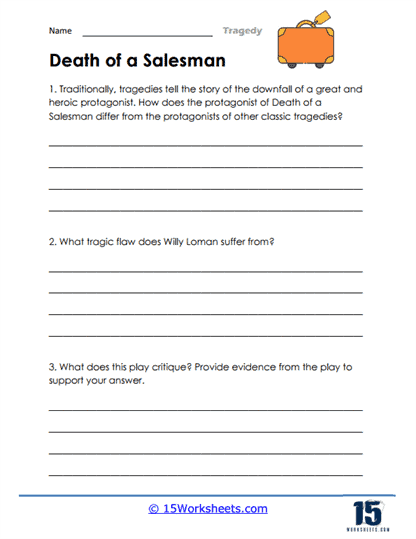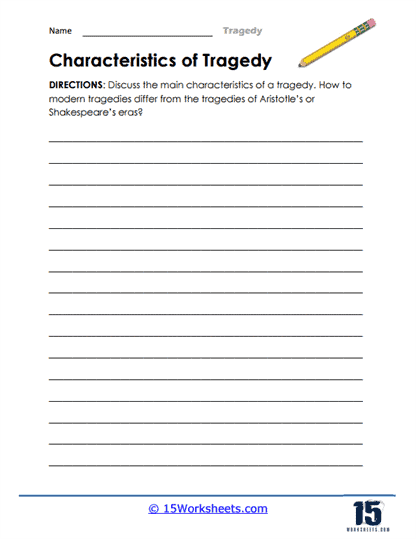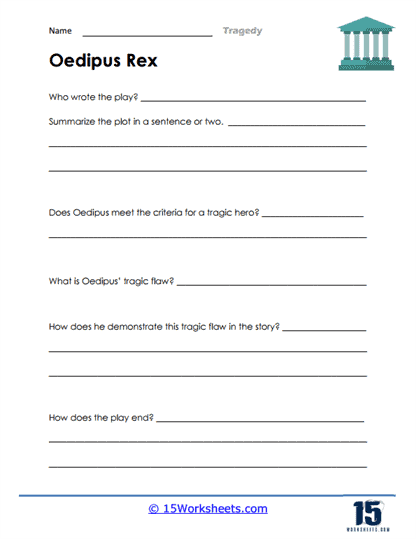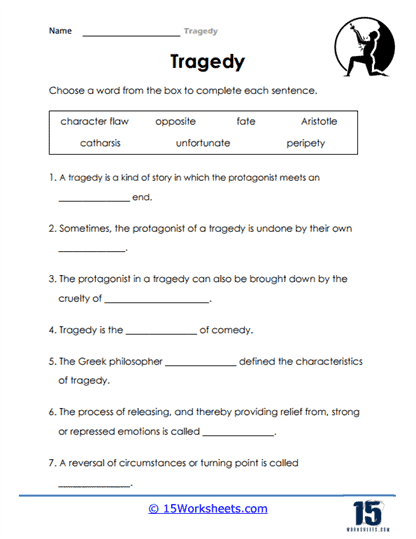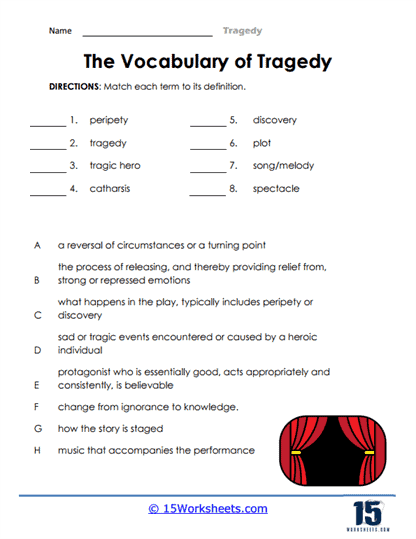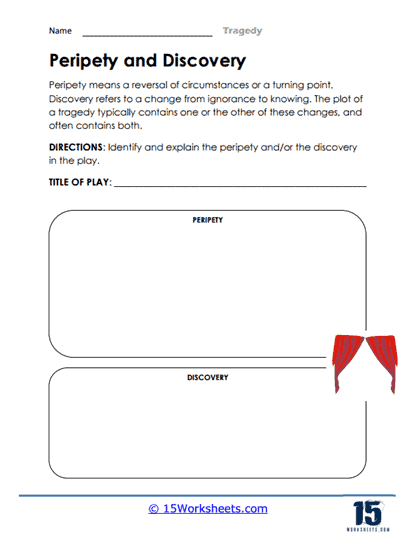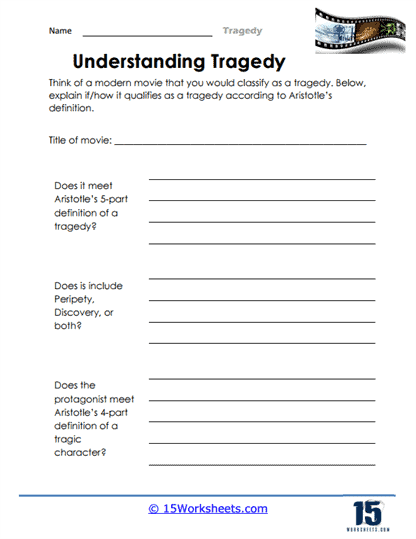Tragedy Worksheets
All About These 15 Worksheets
Tragedy, a genre of storytelling that explores the depths of human suffering and the consequences of our actions, is a timeless and emotionally charged form of literature that challenges readers to reflect on the human condition. Understanding tragedy is not only important for literary appreciation but also for fostering empathy, critical thinking, and a profound insight into the complexities of human existence.
This collection of 15 worksheets is designed to introduce students to the world of tragedy, helping them grasp the importance of this literary genre, recognize its various forms, and develop their own analytical and empathetic skills.
What Are Tragedy Worksheets?
These worksheets help students better understand and explore the concept of “tragedy” in literature. Tragedy is a kind of story that usually ends sadly, often with the downfall of the main character. Tragic stories are important because they can teach us about consequences, and help us think about right and wrong, and cause and effect.
These worksheets can be simplified to make the understanding of tragedy more accessible. The exercises focus on identifying the tragic elements in a story, figuring out the character flaws that lead to the protagonist’s downfall, and understanding the emotional effect of the tragedy on the reader.
Here are some exercises that you will find on these worksheets:
Tragic Hero Identification – This involves reading short summaries of stories and identifying which character is the tragic hero – the character whose actions drive the story towards a sad end. Here, you would explore the traits or decisions that lead to the character’s downfall. For instance, you could be asked why a character made a particular decision and what its tragic outcomes were.
Emotional Response – These exercises ask about your feelings towards the characters and the tragic outcome of the story. You might be asked how the story might have ended differently if the characters had made different decisions.
Plot Mapping – Some worksheets involve drawing the plot of a tragic story, marking the critical points leading to the tragic end.
Why Do Authors Use Tragedy As a Literary Device?
Tragedy is a form of drama that emerged in ancient Greece and has maintained an enduring presence in world literature. The term tragedy originates from the Greek word “tragoidia,” which means “goat-song,” linked to the ritual sacrifice that was part of the early Greek tragic festivals. Tragedy is a narrative, often in the form of a play, in which the main character or protagonist, generally a person of importance or outstanding personal qualities, falls to disaster through the combination of a personal failing and circumstances with which he or she cannot deal.
The main defining feature of a tragedy is its serious nature and the sad or disastrous conclusion, often involving the death or downfall of the main character. A tragic story evokes emotions of pity and fear in the audience, allowing for catharsis, or emotional release, according to Aristotle’s definition in his work “Poetics.” In tragedies, protagonists face conflicts that are beyond their control and often stem from errors or character flaws.
One classic example of tragedy is Shakespeare’s “Romeo and Juliet”. Here, the protagonists, Romeo and Juliet, are victims of their families’ ongoing feud and prejudices. They fall in love, but the circumstances and their impulsive actions lead to their untimely deaths. Their tragic end serves as a strong commentary on the senseless hatred and societal pressures that surrounded them, thus engaging the audience in a deep, emotional, and reflective experience.
Another example is Sophocles’ “Oedipus Rex.” Oedipus, the king of Thebes, is doomed from birth as it was prophesied that he would kill his father and marry his mother. Despite his efforts to escape this fate, he unknowingly fulfills the prophecy. His tragic downfall is not only because of his hubris but also due to the inevitable fate that he was unable to escape. The play engages the audience in a profound exploration of fate, free will, and the tragic consequences of Oedipus’s actions.
Arthur Miller’s “Death of a Salesman” presents a modern take on tragedy. The protagonist, Willy Loman, is a common man rather than a noble one. His downfall is the result of his illusions about the American Dream and his belief that popularity and charisma are the keys to success, while disregarding the importance of hard work and reality. This play challenges the audience’s perspective about success and the tragic consequences of living in illusion.
The appeal of tragedies in literature is timeless, with these stories serving as cautionary tales, morality lessons, or profound explorations of the human condition. Authors use tragedy to depict the reality of life’s harshness and uncertainties, while simultaneously engaging the readers or viewers in a deep emotional experience. Through tragedy, authors highlight the consequences of the protagonist’s actions or decisions, prompting readers to reflect on their own lives and actions.
Benefits Of Tragedy Worksheets To Students
Exploring the world of tragedy through this collection of 15 worksheets offers students an opportunity to develop essential skills in literary appreciation, empathy, critical thinking, ethical reflection, and cultural and historical awareness. Tragedy is a genre that invites students to reflect on the human condition, moral choices, and the consequences of our actions.
By engaging with these exercises and activities, students not only enhance their academic abilities but also gain valuable tools for empathetic understanding, ethical contemplation, and a deeper appreciation of the complexities of human existence. The benefits of studying tragedy extend far beyond the classroom, empowering students to be more empathetic, thoughtful, and culturally aware individuals in an increasingly interconnected and morally complex world.

